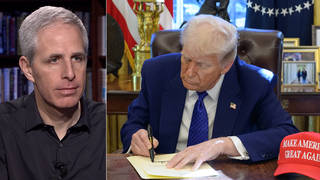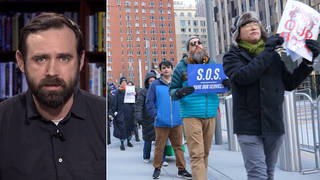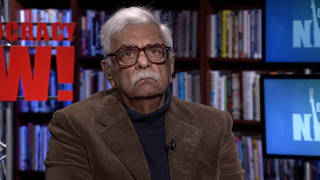
Related
Topics
Guests
- Ziva Branstetterenterprise editor at Tulsa World. She was one of 12 media witnesses to attend the botched execution Tuesday at the Oklahoma State Penitentiary.
An Oklahoma death row prisoner has died of a heart attack after a botched execution Tuesday night. Clayton Lockett was injected with an untested cocktail of lethal drugs. After struggling violently on the gurney, doctors halted the killing 13 minutes in, when discovering Lockett was still conscious and trying to speak. Doctors say he suffered a ruptured vein, interrupting the flow of the lethal drugs. About 30 minutes after that point, Lockett apparently died of a heart attack when the drugs had spread through his body. The botched killing forced officials to cancel the execution of another prisoner, Charles Warner. Both Lockett and Warner initially won a stay of execution earlier this month after challenging the secrecy of their execution drugs. But the Oklahoma Supreme Court reversed the decision last week after Oklahoma Gov. Mary Fallin objected and state lawmakers threatened the judges’ removal from the bench. Warner’s execution has now been delayed for 14 days pending a review of execution procedures. We are joined by journalist Ziva Branstetter of Tulsa World, who was one of 12 media witnesses to attend the planned execution at the Oklahoma State Penitentiary.
Transcript
NERMEEN SHAIKH: An Oklahoma prisoner who was supposed to be executed Tuesday night died instead of a massive heart attack after his lethal injection was botched. Clayton Lockett was injected with an untested cocktail of lethal drugs. After struggling violently on the gurney, doctors halted the killing 13 minutes in, when discovering Lockett was still conscious and trying to speak. Doctors say he suffered a ruptured vein, interrupting the flow of the lethal drugs. About 30 minutes after that point, Lockett died of a heart attack when the drugs had spread through his body. Oklahoma Department of Corrections Director Robert Patton described what happened.
ROBERT PATTON: As those that were inside witnessed, it was determined that he was sedated at approximately seven minutes into the execution. At that time, we began pushing the second and third drugs in the protocol. There was some concern at that time that the drugs were not having the effect, so the doctor observed the line and determined that the line had blown. After conferring with the warden, and unknown how much drugs had went into him, it was my decision at that time to stop the execution. I notified the attorney general’s office, the governor’s office of my intent to stop the execution, and requested a stay for 14 days for the second execution scheduled this afternoon. At approximately 7:06 hours, inmate suffered what appears to be a massive heart attack and passed away.
NERMEEN SHAIKH: Oklahoma Department of Corrections Director Robert Patton. The botched killing of Clayton Lockett forced officials to cancel the execution of another prisoner, Charles Warner. Both Lockett and Warner were convicted of murder. They each won a stay of execution earlier this month after challenging the secrecy of their execution drugs. But the Oklahoma Supreme Court reversed the decision last week after Oklahoma Governor Mary Fallin objected and state lawmakers threatened their removal from the bench. Warner’s execution has now been delayed for 14 days pending a review of execution procedures.
AMY GOODMAN: Clayton Lockett’s execution was second—was the second one botched this year in the United States. In January, an Ohio prisoner named Dennis McGuire was executed using an untested two-drug method. He made snorting and gasping sounds before he died, prompting his family to file a civil rights lawsuit and a call for a death penalty moratorium. Tuesday was the first time since 1937 that two men were set to be executed on the same day in Oklahoma since the death penalty was reinstated in 1976, although it’s happened in other states. The last double execution was in Texas in 2000.
For more, we go directly to Tulsa via Democracy Now! video stream, where we’re joined by Ziva Branstetter. She’s the enterprise editor at the Tulsa World. She was one of 12 media witnesses to attend the botched execution Tuesday at the Oklahoma State Penitentiary.
Ziva, I understand this is just hours after you have experienced what has to be extremely upsetting. And I was wondering, as you wrote up this minute-by-minute account of what you saw, could you start at the beginning, even before the execution began, what you heard in the prison as you walked to the execution chamber?
ZIVA BRANSTETTER: Well, typically inmates will bang on their cells before an execution, for most inmates who are being executed, unless it’s an inmate that none of the other inmates like. And so, we heard a lot of clanging and banging on the cell doors before we were let into the execution chambers.
AMY GOODMAN: And then describe what happened once you got to the execution chamber, and set the scene for us—where you are, where the prisoner who’s about to be executed is, how you can see him.
ZIVA BRANSTETTER: Yes. So the prisoner is in a separate room. The blinds are drawn. We’re in a room that has sound, microphone connection to the execution chamber. We’re in a viewing room. There’s two rows of metal folding chairs. We are in the back row—there’s a dozen media witnesses—two defense attorneys in the front row, and then the rest of the seats in front of us are filled up by state law enforcement officials, Department of Corrections officials, those types of folks. Behind us, there’s a small room with a one-way viewing glass where the victim’s families—relatives sit. So, we were seated. We were ready. The execution began at—began at 6:23, which is later than the other three executions I’ve witnessed. We were wondering why it took a while to start.
NERMEEN SHAIKH: And, Ziva, at some point during the execution, they closed the blinds, even for the media witnesses. Is that right?
ZIVA BRANSTETTER: That’s correct. So what happened is, at 6:23, the execution began. The inmate had no last words. About 10 minutes later, they pronounced him unconscious. There was no reaction for about three minutes. And then, at about—about, you know, I would say three minutes after that, he began a very violent reaction. He began writhing, lifting his shoulders up off the gurney and his head up off the gurney. He was clenching his jaw, exhaling. He was mumbling phrases that none of us could really hear. The only audible word we could hear was him saying “man.” And he appeared to be in pain, but we couldn’t understand what he was saying. This lasted for about three minutes. The physician in the execution chamber went over, lifted up the sheet, looked at his right arm. The warden of the Oklahoma State Penitentiary, who was also in the execution chamber, said that they were going to have to temporarily close the blinds. And after that, they never reopened them.
AMY GOODMAN: I don’t understand. You were witnesses. Why did they close the blinds?
ZIVA BRANSTETTER: Their policies allow them to do that. I haven’t had time to check in detail exactly what else the policies say. Clearly something had gone wrong with the execution. My understanding—we were told later that it was a vein issue with the inmate, and they—we don’t know what happened after that. That’s part of the story that we’re going to try to find out.
NERMEEN SHAIKH: Well, apparently the director of the Department of Corrections, Robert Patton, said that his veins, quote, “exploded” during the botched execution. Could you talk about, Ziva, the cocktail of drugs that was used in this execution that was apparently untested?
ZIVA BRANSTETTER: They used a three-drug cocktail of midazolam, which is a sedative; vecuronium bromide, which is a paralytic that’s intended to stop breathing; and potassium chloride, which is intended to stop the heart. The first drug was a new—was the new drug for Oklahoma. So they used 50 milligrams of that drug in each arm. It’s my understanding that Florida uses that same combination, but midazolam in a much higher quantity than Oklahoma used.
AMY GOODMAN: I want to read a statement from the attorney for Charles Warner, the second Oklahoma prisoner who was set to be executed Tuesday night before it was delayed because of, well, what happened with Lockett. Madeline Cohen, an assistant federal public defender, said, quote, “After weeks of Oklahoma refusing to disclose basic information about the drugs for tonight’s lethal injection procedures, tonight, Clayton Lockett was tortured to death.” She went on to say, quote, “We must get complete answers about what went wrong. There must be an independent investigation conducted by a third-party entity, not the Department of Corrections. We also need an autopsy by an independent pathologist and full transparency about the results of its findings. Additionally, the state must disclose complete information about the drugs, including their purity, efficacy, source and the results of any testing. Until much more is known about tonight’s failed experiment of an execution, no execution can be permitted in Oklahoma,” she said. That was the statement by the public defender, Madeline Cohen. Your thoughts on this and how this all happened last night? I mean, this was not in a vacuum, Ziva; there’s been a court battle with the governor around what these drugs were and whether these executions would move forward last night.
ZIVA BRANSTETTER: My thoughts are that, as a member of the media who witnessed the event itself, I would like more answers. I plan to ask for them today. I’m sure that the attorneys involved will be filing various appeals. We were told by the Department of Corrections last night that they haven’t even determined that this qualified as an execution, because he died of a heart attack 43 minutes later. So, there are some unanswered questions. And we, as members of the media, would like to have answers.
AMY GOODMAN: When the curtains were then closed on you, when you were no longer able to see what was happening, what then happened next?
ZIVA BRANSTETTER: We waited for about 10 minutes. The Department of Corrections director, Robert Patton, came in and said—told us what had happened, that the—he had—the execution had been halted. He said that the second execution had been stayed. Then he left the room. Eventually, five or so minutes later, we were told that—to leave the execution chamber. So we did. We got back into the prison vans and left and went back to the media center, where we discussed what we had seen with other reporters, as required by our pool arrangement.
NERMEEN SHAIKH: In March, Democracy Now! spoke with Susan Greene, editor of The Colorado Independent, about how one of her reporters obtained email documents showing the assistant Oklahoma attorney general joking with a Texas colleague that he might be able to help Texas get the drugs in exchange for 50-yard-line tickets for a top college football game between the University of Oklahoma and the University of Texas. She also described documents that exposed how Oklahoma injected leftover lethal drugs into the bodies of dead prisoners.
SUSAN GREENE: So they had these syringes, and basically, the men would die with the first drug, the anesthetic. They would die of an overdose, which is really not how it’s intended. And because they had these two other syringes in his three-drug cocktail, to stop their breathing and to stop their heart, instead of just throwing them out, they injected them into the dead bodies for disposal purposes. So it didn’t just happen in one case; it happened in nine cases. And we’re pretty sure that the families of those men don’t know that that happened. Even though they were watching the procedure, they don’t know that those men were already dead. And instead of just throwing the syringes out and throwing the drugs out, they’re just injecting them into their bodies to get rid of them.
NERMEEN SHAIKH: That was Susan Greene, the editor of The Colorado Independent. Ziva, your response to what she had to say?
ZIVA BRANSTETTER: I think it’s interesting. I can’t speak for their reporting, since we didn’t do that reporting. I am familiar with their report.
AMY GOODMAN: This whole issue of the death penalty in Oklahoma and getting the drugs, and now the second execution put on hold for at least, at this point, 14 days, talk about the judges who first ruled that the executions should be stayed, the governor overruling them, and now the call for the judges—what is it—to be impeached?
ZIVA BRANSTETTER: There was one lawmaker who has filed articles of impeachment. Many of the lawmakers don’t think that’s going to go very far. There’s—the governor said in her executive order that she believed the Supreme Court had overstepped its authority in issuing a stay of execution. The Supreme Court in Oklahoma usually doesn’t decide on criminal cases, but they did in this case. They felt like they had the right to do so. Ultimately, they dissolved their own stay, and the execution went forward.
AMY GOODMAN: And the governor’s response, now that she pushed forward for the execution, and it has just become this debacle?
ZIVA BRANSTETTER: She has called for a full investigation, so we’ll have to see what that reveals.
NERMEEN SHAIKH: And, Ziva, you’ve witnessed, you mentioned, three other executions in the past. How does the length of this execution, 43 minutes, if it is indeed an execution, which remains to be seen, since he did die of a heart attack, compare to the other executions you’ve witnessed? The average length is apparently six minutes.
ZIVA BRANSTETTER: Yes, it’s by far longer than any execution I’ve witnessed. But, you know, by far.
AMY GOODMAN: Finally, Ziva, I know you have to go, but your final thoughts in this—these hours after the execution?
ZIVA BRANSTETTER: My final thoughts are I want to get to the newsroom, and I have a lot of questions that I, as a journalist, want to answer so that we can tell our readers what happened. Whether you’re for or against the death penalty, you want to know what happened last night.
AMY GOODMAN: We want to thank you very much for taking this time to speak to us, Ziva Branstetter, enterprise editor at the Tulsa World, one of 12 media witnesses to attend the botched execution Tuesday at the Oklahoma State Penitentiary of Clayton Lockett. The second execution was put off as a result of what happened with the first, and it was the first time since 1936 that two people were slated to be executed in one night in Oklahoma.
This is Democracy Now!, democracynow.org, The War and Peace Report. We’re going to stay on the issue of the death penalty when we come back, but we’re going from Oklahoma to Egypt, where hundreds of members of the Muslim Brotherhood have been sentenced to death. Stay with us.












Media Options